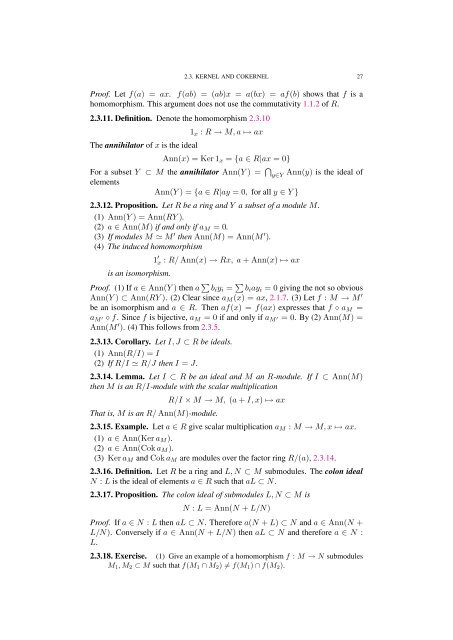Commutative algebra - Department of Mathematical Sciences - old ...
Commutative algebra - Department of Mathematical Sciences - old ...
Commutative algebra - Department of Mathematical Sciences - old ...
Create successful ePaper yourself
Turn your PDF publications into a flip-book with our unique Google optimized e-Paper software.
2.3. KERNEL AND COKERNEL 27<br />
Pro<strong>of</strong>. Let f(a) = ax. f(ab) = (ab)x = a(bx) = af(b) shows that f is a<br />
homomorphism. This argument does not use the commutativity 1.1.2 <strong>of</strong> R.<br />
2.3.11. Definition. Denote the homomorphism 2.3.10<br />
The annihilator <strong>of</strong> x is the ideal<br />
1x : R → M, a ↦→ ax<br />
Ann(x) = Ker 1x = {a ∈ R|ax = 0}<br />
For a subset Y ⊂ M the annihilator Ann(Y ) = <br />
y∈Y Ann(y) is the ideal <strong>of</strong><br />
elements<br />
Ann(Y ) = {a ∈ R|ay = 0, for all y ∈ Y }<br />
2.3.12. Proposition. Let R be a ring and Y a subset <strong>of</strong> a module M.<br />
(1) Ann(Y ) = Ann(RY ).<br />
(2) a ∈ Ann(M) if and only if aM = 0.<br />
(3) If modules M M ′ then Ann(M) = Ann(M ′ ).<br />
(4) The induced homomorphism<br />
is an isomorphism.<br />
1 ′ x : R/ Ann(x) → Rx, a + Ann(x) ↦→ ax<br />
Pro<strong>of</strong>. (1) If a ∈ Ann(Y ) then a biyi = biayi = 0 giving the not so obvious<br />
Ann(Y ) ⊂ Ann(RY ). (2) Clear since aM(x) = ax, 2.1.7. (3) Let f : M → M ′<br />
be an isomorphism and a ∈ R. Then af(x) = f(ax) expresses that f ◦ aM =<br />
aM ′ ◦ f. Since f is bijective, aM = 0 if and only if aM ′ = 0. By (2) Ann(M) =<br />
Ann(M ′ ). (4) This follows from 2.3.5.<br />
2.3.13. Corollary. Let I, J ⊂ R be ideals.<br />
(1) Ann(R/I) = I<br />
(2) If R/I R/J then I = J.<br />
2.3.14. Lemma. Let I ⊂ R be an ideal and M an R-module. If I ⊂ Ann(M)<br />
then M is an R/I-module with the scalar multiplication<br />
That is, M is an R/ Ann(M)-module.<br />
R/I × M → M, (a + I, x) ↦→ ax<br />
2.3.15. Example. Let a ∈ R give scalar multiplication aM : M → M, x ↦→ ax.<br />
(1) a ∈ Ann(Ker aM).<br />
(2) a ∈ Ann(Cok aM).<br />
(3) Ker aM and Cok aM are modules over the factor ring R/(a), 2.3.14.<br />
2.3.16. Definition. Let R be a ring and L, N ⊂ M submodules. The colon ideal<br />
N : L is the ideal <strong>of</strong> elements a ∈ R such that aL ⊂ N.<br />
2.3.17. Proposition. The colon ideal <strong>of</strong> submodules L, N ⊂ M is<br />
N : L = Ann(N + L/N)<br />
Pro<strong>of</strong>. If a ∈ N : L then aL ⊂ N. Therefore a(N + L) ⊂ N and a ∈ Ann(N +<br />
L/N). Conversely if a ∈ Ann(N + L/N) then aL ⊂ N and therefore a ∈ N :<br />
L.<br />
2.3.18. Exercise. (1) Give an example <strong>of</strong> a homomorphism f : M → N submodules<br />
M1, M2 ⊂ M such that f(M1 ∩ M2) = f(M1) ∩ f(M2).
















